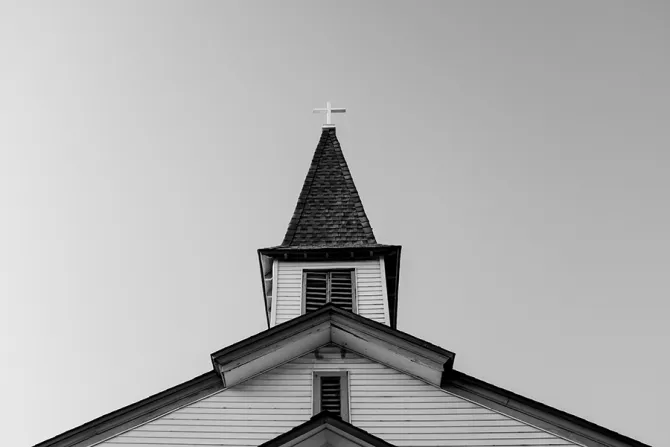Vatican City, Jul 10, 2018 / 13:49 pm
St. Catherine of Siena Church was built by immigrants in a Catholic Boston neighborhood, in the late nineteenth century. For more than a century, it welcomed the poor, the lost, and the searching. Then in 2008, the church was closed.
A decade later the building opened its doors again, welcoming a new generation of seekers. But while the sanctuary is empty, the basement of the building has become a Dollar Tree, and those who enter are searching mostly for a bargain.
Around the world, with demographic shifts and a decline of worshippers in some countries, a growing number of church buildings are being closed. Safeguarding the sanctity of the once-hallowed ground where believers prayed and worshiped is becoming a perplexing problem for Church leaders.
To answer the tough question about what to do with shuttered churches, the Vatican has decided to host a conference from Nov. 29-30, addressing the issue from a multi-disciplinary perspective, in light of a growing interest in protecting the historic and cultural significance many churches still hold, even if they are unused.
The"God No Longer Lives Here?" conference is being organized by the cultural goods department of the Pontifical Council for Culture, the Italian bishops conference, and the Pontifical Gregorian University's Faculty of History and Cultural Heritage of the Church.
At a July 10 press conference announcing the November event, Cardinal Gianfranco Ravasi, president of the Vatican's culture office, said the problem of what to do with churches or sacred places that are no longer used is a "transversal" problem, with historic, spatial, socio-cultural and even academic and legal dimensions.
When the idea to host a conference about the topic was initially pitched, Ravsi said he was skeptical, thinking the issue would only be of interest to a small pool of experts, however, instead there was an "extraordinary reaction" not only from bishops conferences, but also academics and even UNESCO, who in the past has sent representatives to episcopal conference meetings to hear their thoughts on the closing of ancient religious structures believed to hold special cultural and historic significance.
In comments to the press, Ravasi said that while the issue of what to do with churches that have been closed has always been an issue, the current increase in interest is "one of the mirrors of the decline of religious practice, of secularization," and of "a lack of priests."
The prime reasons churches are shut down is due to the small size of the congregation that attends services, to a lack of priests, or when parishes merge for pastoral reasons, Ravisi said.
The conference, then, will help to highlight the crisis in the decline of belief, but it will also ensure that churches and other sacred places are not sold off to buyers who will but them to profane use given the history of the structure.
Part of the goal of the November conference will be to draft guidelines for what to do with churches that are de-consecrated and potentially sold.
The first day of the conference will be dedicated to several talks pitching ideas for solutions, followed by discussion. The second and final day will be dedicated to further discussion and the drafting of the guidelines, which will either be published as a directive from the Vatican's Council for Culture, or they will be adopted and published at a more universal level as a document from the Holy See, though modifications will likely be made if the latter is the case.
Representatives of bishops' conferences, the Vatican's culture office and university professors will add their voice to the discussion, offering their own contribution for what the guidelines should include.
Conference organizers also announced a photo contest that will take place primarily on Instagram, with the hashtag "#nolongerchurches," and will encourage photographers to document what happens to de-consecrated churches. The photos selected will also be displayed in an exhibit, and they will be published in the Italian Magazine "Arte cristiana, Casabella e Chiesa: architettura e communicazione."
In comments to the press, Archbishop Nunzio Galantino, president of the Administration of the Patrimony of the Holy See (APSA) and until now secretary general of the Italian bishops conference, said the topic of what to do with de-consecrated churches is a "salient issue," and one that is important for the Italian bishops.
Though the question of what to do with an increase in churches being closed is primarily a problem in France, Belgium, Holland, Germany and Switzerland, according to a press release on the conference, Italy, the United States and Canada have also faced similar dilemmas.
(Story continues below)
And opposition to the sale of sacred spaces has increased even among non-believers, many of whom believe churches, even if unused, add historic, cultural and artistic value to their communities.
"What is the situation today? We have a change of context," he said, pointing to the problem of decreasing Mass attendance, priest shortages and the closing of rural churches which have gone unused for years.
The issue is a social, cultural and economic problem, he said, explaining that when these churches belong to dioceses and parishes, it is easier to keep them in use and take care of them, but when these churches are no longer associated with a diocese or parish, often and unfortunately "there is a private interest" involved in what happens to it.
Professor Ottavio Bucarelli, who works at the Faculty of History and Cultural Heritage of the Church at the Gregorian University in Rome, was also present at the press conference, and told journalists the "sacred nature" of places of worship must always be respected.
"A church remains a church even when it is no longer a church, even when it has been transformed into something else," he said, "so at a certain point we have to respect the faith of so many believers who have prayed and worshiped there for centuries."



